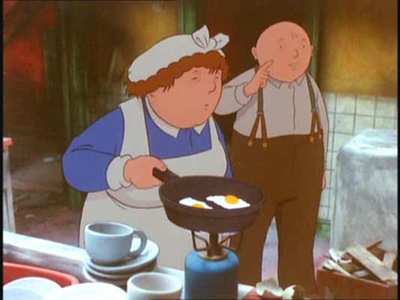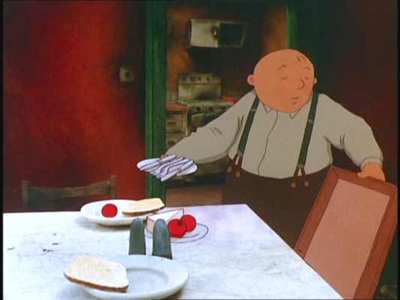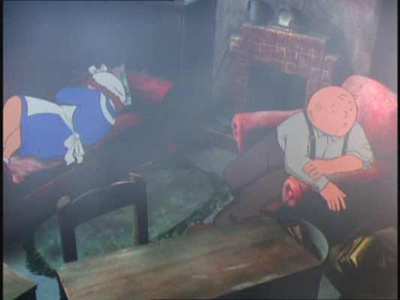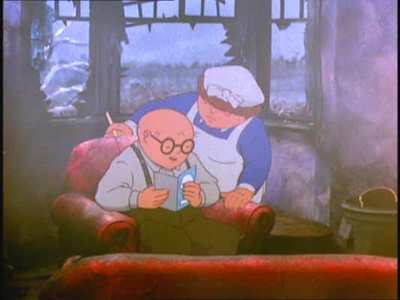Review of When The Wind Blows
Introduction
`When the winds blow I will call…` sang Midge Ure on a song of the same name from his first solo album The Gift in 1985. He may well have been reading a Raymond Briggs book that definitely contained no snowmen or Aled Jones, but then it was also at the height of the Cold War where fear of Mutual Assured Destruction was at its peak. Just a year before he`d had a number 2 hit with the nuclear-inspired hit `Dancing With Tears In My Eyes`, so it`s not unthinkable that he might have returned to a subject close to many peoples fears at the time.
The following year David Bowie had a go with a song of the same title (a minor number 44 hit in 1986), but this time it was the theme tune to a film adaptation of Raymond Briggs` When The Wind Blows. This book revolves around a retired working class couple, Jim (John Mills) and Hilda (Peggy Ashcroft), who live a tranquil life in a small house in the English countryside.
The couple are simple, but not stupid, and quite set in their own different ways. Although they live in the nuclear age, Hilda still believes that a pre-emptive strike is something the unions do and that fallout is a command given in the Army. Mild-mannered Jim, on the other hand, is a firm believer in `the powers that be` in a way that would be manna from heaven to the current incumbents of Downing Street.
Spending the morning reading the papers in the public library during a current world crisis, Jim has brought back the latest Government leaflets on what to do in the event of a nuclear blast. That afternoon a radio newscaster gives the comforting news that war is due to break out within three days. A stunned Jim dives into the leaflets and starts making preparations according to the Whitehall mandarins, whilst Hilda does the washing and makes a cup of tea or two.
After Jim has done his best to follow the instructions (ripping down doors and making a shelter at the requisite 60 degree angle, painting the windows white to deflect radiation, gathering up old paper potato sacks as protective clothing), the dreaded news comes that a nuclear strike is three minutes away! Hilda thinks she`d better get the washing in, but is grabbed by a swearing (!) Jim who thrusts her into the small shelter.
With the nuclear blast over, the couple must make full use of their knowledge of wartime conditions during World War II, that old Blitz spirit and their ever-dwindling meagre supplies to survive…

Video
Simply a gorgeous transfer that shows real care, with lush colours for the most part, of a film that is a combination of both live footage and animation, the latter all hand drawn and placed in front of real backgrounds. Dream sequences and bomb blast are animated in a rough hand sketch technique with a blue background for the former and orange, appropriately enough, for the latter. You can pick out some dirt, especially noticeable over the title sequence, but in my opinion that is due to the animation technique of using transparencies over a background rather than print damage.

Audio
Nice soundtrack, although it`s only Dolby Digital 2.0. This is fine for this feature and is powerful enough anyway. The music soundtrack is suitably heavyweight for a mid-80`s film, scored as it is by Roger Waters, ex-Pink Floyd at this point (his score contains samples and music that is so reminiscent of Floyd anyhow…). Songs are also included by Genesis, Squeeze, Paul Hardcastle (not n-n-n-n-n-n-Nineteen or The Wizard, thankfully) and Hugh Cornwell.

Features
The Wind And The Bomb - a Making Of featurette dating from the time of the film that lasts for 25 minutes and covers the animation techniques in some detail. Contains some dodgy haircuts and fashion from the animation team, but nothing too garish. Also slight overlap with the other extra as Raymond Briggs intro is on here too…
Interview With Raymond Briggs - a 13 minute interview with the main man, who talks about whatever takes his fancy for the duration, mostly it has to be said about his parents. Still contains some interesting insights though.

Conclusion
Well, I have to admit that while I`ve heard of both this and most of Briggs other popular pieces of work, I`ve never read one of his books or seen any of the films (bar the Aled Jones thing on Top Of The Pops when I wasn`t fast enough to turn it over - no remote then, you see…). The 80`s was also a time of immense public fear of a nuclear war as East and West glowered at each other through suspicious eyes. This is probably something that the younger generation won`t understand in the same way that my generation can never truly understand how close the world came to ending during the Cuban Missile Crisis. Films started to come out on the subject, songs hit the charts, and books such as General Sir John Hackett`s The Third World War (although it was written in 1978) and Tom Clancy`s Red Storm Rising rode high on the bestseller lists.
Most talk on this possibility of nuclear strike centred on the high-level view of these events with dry talk of casualty numbers, this animated film looks at the lives of two ordinary retired people who are simply naïve in their views of the world situation and the expert knowledge of Government. The significance of a nuclear blast is set against the banality of the lives of people not involved in any part of the high-level drama as they struggle to survive, the odds set against them by Jim`s unswerving belief in the instructions of the Government of the day and Hilda`s unswerving devotion to her husband.
Whilst the subject is a very serious one, you can`t help but laugh in disbelief as Jim continually refers to and reads aloud from the infamous Official literature of that time (watch in disbelief as Government and County Council advice is different, causing confusion and angst for Jim). Alongside that though, is the growing sense of unease of what fate will inevitably befall this innocent but loving couple as conditions worsen, health deteriorates and neither knows what is happening in the outside world, still relying on the milkman for supplies and the paperboy for news. It`s ultimately a hopeless situation, but we are fortunate to be spared that despite knowing the real ending as Hilda whimpers her last despairing sentence and Roger Waters starts to pipe up as the credits roll. Keep some Kleenex handy though as you`ll probably need it.
An excellent and hugely understated yet beautiful film that deserves to be seen again nearly 20 years after its release…
Your Opinions and Comments
Be the first to post a comment!